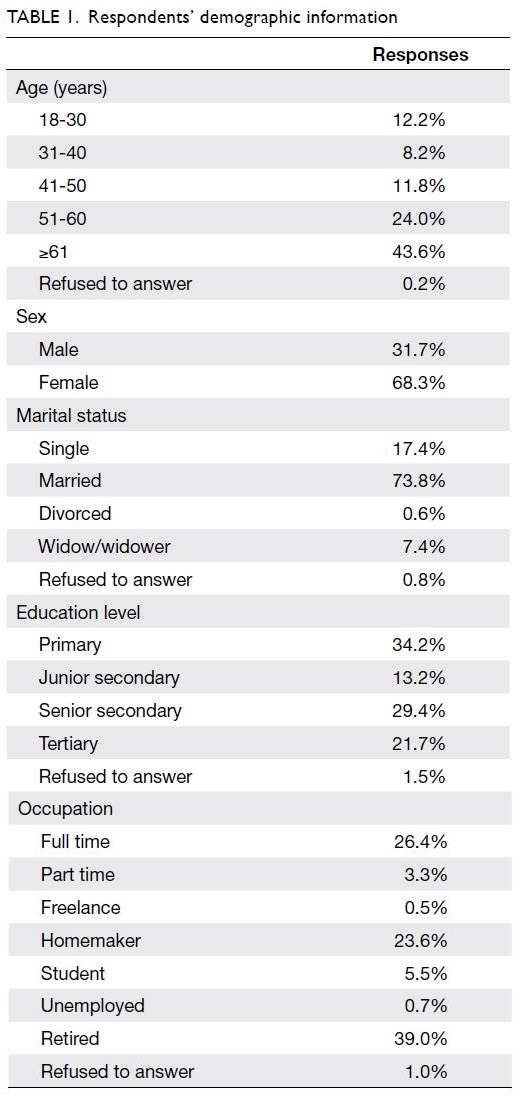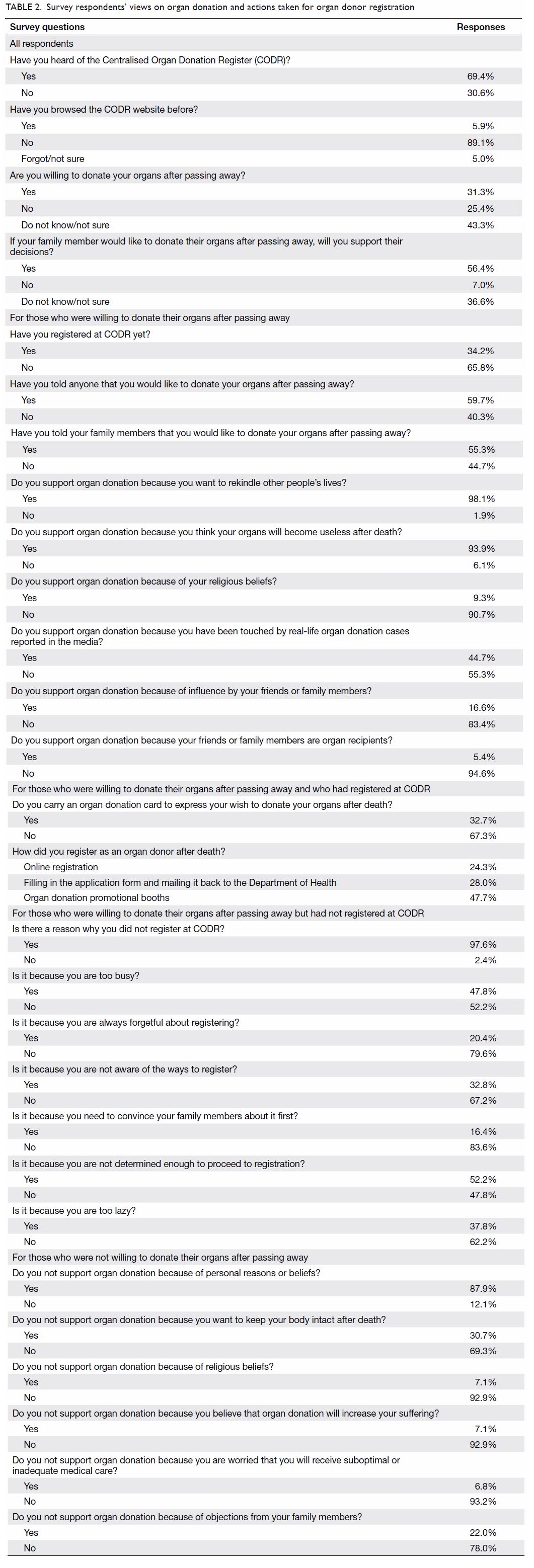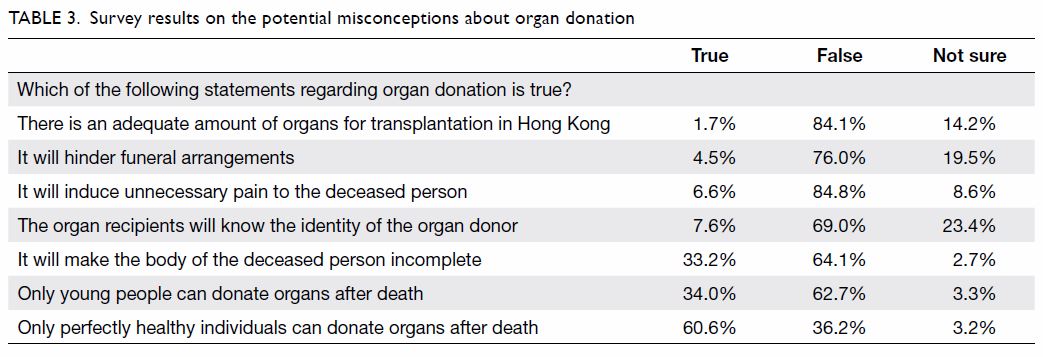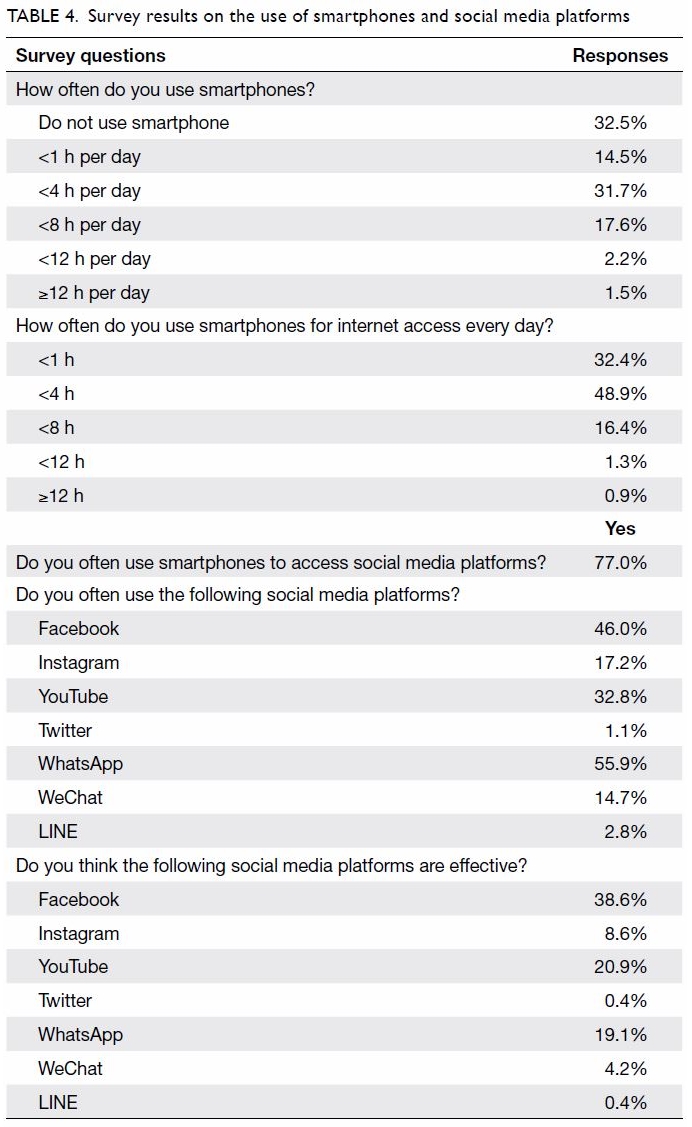Hong Kong Med J 2020 Jun;26(3):192–200 | Epub 21 May 2020
© Hong Kong Academy of Medicine. CC BY-NC-ND 4.0
ORIGINAL ARTICLE
Attitudes, acceptance, and registration in relation
to organ donation in Hong Kong: a cross-sectional study
Jeremy YC Teoh, FRCSEd (Urol), FHKAM (Surgery)1; Becky SY Lau, BSc, MPH1; Nikki Y Far, FCOphth HK, FHKAM (Ophthalmology)2; Steffi KK Yuen, FRCSEd (Urol), FHKAM (Surgery)1; CH Yee, FRCSEd (Urol), FHKAM (Surgery)1; Simon SM Hou, FHKAM (Surgery)1; Timothy SC Teoh, FHKAM (Surgery)3; CF Ng, FRCSEd (Urol), FHKAM (Surgery)1
1 SH Ho Urology Centre, Department of Surgery, Prince of Wales Hospital, The Chinese University of Hong Kong, Hong Kong
2 Department of Ophthalmology and Visual Sciences, Prince of Wales Hospital, The Chinese University of Hong Kong, Hong Kong
3 Lions Kidney Educational Centre & Research Foundation, Hong Kong
Corresponding author: Prof Jeremy YC Teoh (jeremyteoh@surgery.cuhk.edu.hk)
Abstract
Introduction: The objective of this study was to
investigate the discrepancy between individuals
with positive attitudes towards organ donation and
the actual number of registered organ donors in
Hong Kong, and to investigate the best modalities
for promoting more organ donor registrations.
Methods: This cross-sectional telephone survey was
conducted in Hong Kong. Telephone numbers were
selected randomly. Upon successful contact with a
household, the eligible household member who had
the most recent birthday was selected to participate
in the telephone interview.
Results: A total of 1000 Hong Kong Chinese residents
were interviewed successfully. The response rate was
53.8%. The majority of the respondents were female
(68.3%) and were aged 51 to 60 years (24%) or ≥61
years (43.6%). Among the respondents, 31.3% were
willing to donate their organs after death; 43.3% were
indecisive, and 25.4% refused. Among those who
were willing to donate organs after death, only 34.2%
had registered with the Centralised Organ Donation
Register (CODR). Among those who were willing to
donate organs after death but had not yet registered
on CODR, 52.2% said they were not determined
enough to take action, 47.8% said they were too
busy, 37.8% said they were too lazy, and 20.4% said
they were always forgetful about registering. In all, 32.8% of the interviewees were not aware of the ways
to register as a prospective organ donor. Among
non-messenger social media platforms, Facebook,
YouTube, and Instagram were the most commonly
used. Most participants believed that Facebook and
YouTube were effective for engaging audiences.
Conclusions: More effort should be made to
facilitate organ donor registration in face-to-face
settings via promotional booths and in online
settings via appropriate social media platforms.
New knowledge added by this study
- A large proportion of respondents had a positive attitude towards organ donation.
- The majority of respondents who were positive towards organ donation lacked the determination to register as organ donors.
- Among respondents who had registered as organ donors, most did so in person via a promotional booth.
- More effort should be made to proactively reach out to passive-positive donors.
- The importance of taking action to register as a prospective organ donor must be emphasised.
- The use of social media platforms may help engage passive-positive donors and provide immediate opportunities for online registration.
Introduction
In 2017, Hong Kong had a low organ donation ratio of
6.0 deceased donors per million population, whereas
the corresponding ratios were 46.9, 32.0, and 23.1
donors per million population in Spain, the United
States, and the United Kingdom, respectively.1 Among all types of solid organs, there is the greatest
shortage of donated kidneys in our locality. In 2018,
there were 2318 patients on the waiting list for
kidney transplantation.2 However, there were only
60 kidney donations from deceased donors and 16
from living donors in the same year.2 This marked mismatch has led to not only a long average waiting
time for kidney transplantation of 51 months,3 but
also the accompanying costs of prolonged dialysis,
increased risk of dialysis-related complications, and
adverse effects on patients’ quality of life.4 5 6
The majority of organ donations are from
deceased donors. However, without knowing the
wishes of deceased potential donors, it is often
difficult to counsel their family members about
organ donation. Therefore, it is important to
engage the general public in prospective organ
donor registration. Hong Kong has a population
of approximately 7.39 million, but only 284 185
individuals had registered as organ donors via the
Centralised Organ Donation Register (CODR)
through June 2018, corresponding to a registration
rate of 3.8%.7 In contrast, 52.6% of the respondents
of the Behavioural Risk Factor Survey conducted in
Hong Kong reported that they were willing to donate
their organs after death.8 These results suggest that
most people who are willing to donate organs after
death have not yet registered as prospective organ
donors. These individuals represent a group of
passive-positive organ donors who would potentially
become prospective organ donors if successfully
engaged.9
We conducted a local survey to investigate the
underlying reasons for the discrepancy between the
number of individuals willing to donate organs and
the number of registered donors. We postulate that
appropriate use of social media may play a role in
motivating people to register as prospective organ donors. Hence, we also investigated the use of
smartphones and social media platforms by Hong
Kong citizens. The results will be useful for planning
our future directions and strategies for promoting
organ donation.
Methods
A cross-sectional telephone survey of the general
population of Hong Kong was conducted via the
service provided by the Jockey Club School of Public
Health and Primary Care, The Chinese University
of Hong Kong. The survey was designed after
consultation with doctors, nurses, living-related
organ donors, organ recipients, and patient support
groups. Demographic information including age,
sex, marital status, education level, occupation,
religion, smoking habits, drinking habits, exercise
habits, and current health status was collected.
Questions focusing on the respondents’ views about
organ donation and their actions taken with regard
to organ donor registration were asked. Questions
regarding potential misconceptions about organ
donation were also asked. The respondents’ habits
of using smartphones and social media platforms
were also evaluated. To minimise the sampling error,
telephone numbers were first selected randomly
from an updated telephone directory as seed
numbers. Another set of three numbers was then
generated by randomising the last two digits to
recruit unlisted numbers. Duplicate numbers were
then screened out, and the remaining numbers were
mixed in random order to become the final sample.
Interviews were conducted by experienced
interviewers between 10:00 and 22:00 on weekdays
and other periods, including weekends and public
holidays, should appointments with suitable subjects
be arranged. The inclusion criteria for the study
were Chinese Hong Kong residents aged ≥18 years.
Upon successful contact with a target household,
one qualified member of the household was selected
among the family members using the last-birthday
random selection method (ie, the respondent aged
≥18 years in the household who had his/her birthday
most recently was selected) to participate in the
telephone interview. We aimed for the survey to
have 1000 respondents. All results were analysed
and presented descriptively.
Results
From 15 April 2019 to 8 May 2019, telephone
numbers were sampled for the survey until 1000
valid responses from eligible individuals were
received. Of 16 373 telephone numbers called,
14 514 were invalid for various reasons: 6556 were
facsimile/invalid lines, 555 were non-residential
lines, 1008 cut the line immediately, 6366 did not
pick up the phone after three attempts, and 29 were non-Chinese persons. Among the remaining 1859
eligible individuals, 750 refused to participate in the
survey, seven terminated the survey mid-way, and
we failed to contact the remaining 102 after three
attempted calls each. The overall response rate was
53.8% (1000/1859).
The majority of our respondents were female
(68.3%) and within the age-group of 51 to 60 years
(24%) or ≥61 years (43.6%). In total, 73.6% of the
respondents did not have any religious beliefs. The
vast majority of them were non-smokers (95.2%)
and non-drinkers (93.1%). In all, 65.6% of the
respondents exercised regularly, with 65.7% and
10.3% considering themselves “healthy” and “very
healthy,” respectively (Table 1).
Table 2 shows the survey results on the
respondents’ views about organ donation and their
actions taken with respect to organ donor registration.
Unexpectedly, a relatively large proportion of
interviewees (30.6%) had never heard of CODR, and
89.1% of the respondents had never visited the CODR
website. Only 31.3% of the respondents were willing
to donate their organs after death, and 43.3% were
indecisive, while 25.4% refused. When interviewees
were asked if they would support a family member’s
decision to become a prospective organ donor, 56.4%
said they would be supportive, 7% would object, and
36.6% were uncertain. Looking further at the 313
respondents who were willing to become prospective
organ donors, only 34.2% of them had registered on
CODR, whereas 55.3% had expressed such wishes to
their family members. Of those who had registered,
98.1% did so in the hope of rekindling others’ lives,
93.9% believed that their organs would become
useless after death, and 44.7% were influenced by
successful organ donation stories publicised by the
media.
Of the 107 respondents who had registered
to be prospective organ donors, 47.7% did so via
organ donation promotional booths, 28% filled in
the application forms and mailed them back to the
Department of Health, and 24.3% registered online.
Among the 206 respondents who were willing to
donate organs after death but had not yet registered
on CODR, 52.2% said they were not determined
enough to take action, 47.8% said they were too
busy, 37.8% admitted that they were too lazy to
do so, 20.4% said they were always forgetful about
registering, and 32.8% said they were not aware of
the ways to register as a prospective organ donor.
A total of 687 respondents were indecisive or
refused to become organ donors. In all, 30.7% hoped
to keep their bodies intact after death, 7.1% refused
to register because of religious beliefs, 7.1% were
worried that organ donation might increase their
suffering, and 6.8% worried that by agreeing with
organ donation, they would receive suboptimal or
inadequate medical care. In total, 22% were not keen to donate organs owing to objections from family
(Table 2).
The questionnaire also studied potential
misconceptions about organ donation (Table 3). Of
the respondents, 6.6% believed that the process of
organ harvesting would induce unnecessary pain to
the deceased person, and 4.5% worried that organ
harvesting would hinder funeral arrangements. A
total of 60.6% thought that only perfectly healthy
individuals could donate organs after death, 34%
believed only young people could donate organs after
death, and 7.6% believed that the organ recipients
would always know the identity of the organ donor.
Moreover, 1.7% were under the impression that there
was an adequate supply of organs in Hong Kong.
Respondents were interviewed about their
use of smartphones and social media platforms
(Table 4). In all, 77% of the respondents often use
their smartphones to access social media platforms.
Among the various non-messenger types of social
media platforms, Facebook, YouTube, and Instagram
were the most commonly used. The majority of the
respondents believed that Facebook and YouTube
were effective at engaging the audience.
Discussion
There has been a great demand for organ
donations in Hong Kong, yet the number of organ
transplantations conducted is very small. The
organ donation rate in Hong Kong is much lower
than that of many European countries, perhaps
because of cultural, religious, governmental, legal,
and regulatory differences, as well as differences in
the level of intensive care unit support and organ
donation criteria.10 11 12 13 Hong Kong currently follows
the opt-in approach to organ donation, as opposed
to the opt-out approach, which is the standard in
countries like Singapore and Spain. Although the
opt-out approach may increase the availability of
suitable organs for donation, there is a reasonable
concern about differing views between members of
the general public and the potential ethical issues
related to that approach. The degree of knowledge,
awareness, and attitude towards organ donation is
also important for an individual to take action to
become a prospective organ donor.14 More efforts
should be made in these areas to improve the organ
donation rate in Hong Kong.
In 2015, a Behavioural Risk Factor Survey with
a total of 4253 respondents was conducted in Hong
Kong.8 Among the respondents, 52.6% reported that
they were willing to donate their organs after death,
11.3% refused to donate their organs after death,
and the rest remained undecided. However, until
June 2018, the registration rate in Hong Kong was only 3.8%.7 This represents a huge area of potential
improvement if we are able to engage these potential
organ donors successfully.
Our survey showed that only 34.2% of the
respondents who were willing to donate their
organs after death actually completed registration
at CODR. A large proportion of respondents said
they were too busy, too lazy, too forgetful, or simply
not determined enough to take action to register at
CODR. Of the respondents, 32.8% were not aware
of the ways to register as a prospective organ donor.
The majority of the respondents had not heard
about CODR, and only 5.9% had browsed the CODR
website. We need better ways to reach out to these
passive-positive donors and to provide convenient
methods for immediate registration after engaging
them successfully. Our survey showed that the
majority of the respondents use smartphones to
access social media platforms every day and that
Facebook, YouTube, and Instagram are the major
social media platforms being used in Hong Kong.
These social media platforms should be used for any
organ donation promotion activities in the future.
Our survey showed that 47.7% of registered
organ donors completed their registration via
organ donation promotional booths. Face-to-face
settings such as promotional booths allow the best
engagement and interaction with the audience, and
this definitely yields better results, especially for
older adults who may not be familiar with the use of
internet or social media platforms. Booths provide
opportunities for educators to clarify people’s
misconceptions, resolve their queries, and provide
live guidance regarding their registration. Our
survey reflected the effectiveness of organ donation
promotion booths established by the Hong Kong
government in the past. It would be worth investing
more resources to set up regular and frequent
promotion booths in more diverse areas owing to
their promising effects.
Two systematic reviews and meta-analyses
have been conducted to identify effective
community-based interventions to increase organ
donor registration.15 16 Among all studies reviewed,
four randomised controlled trials demonstrated the
effectiveness of an intervention based on an increase
in verified organ donor registrations.17 18 19 20 The first
study investigated the role of group discussions about
organ donation in a church setting together with a
32-minute video featuring organ donation, organ
transplantation, and the personnel involved during
the whole process.17 The second study investigated
the effects of a 5-minute video using an iPod Classic
or iPod Touch with noise-cancelling headphones.18
The video was designed to address a number of
concerns related to organ donation. The participants
were then interviewed and given written information
about organ donation. The third study investigated the role of a brief motivational intervention by hair
stylists that encouraged organ donation.19 Hair
stylists received training on communication skills,
motivational interviewing, and discussion of ways to
integrate organ donation into their client interaction.
Each client was given a package containing
organ donor registration cards. The fourth study
investigated the use of the IIFF model (Immediate
opportunity to register, Information, Focused
engagement, and Favourable activation) to increase
the rate of organ donor registration in the setting of
Secretary of State branch offices.20 Participants were
gathered at the Town Hall, where organ donation
was discussed, and there were registration cards at
the end of the session.
The four successful studies have common
features.17 18 19 20 First, all four studies successfully engaged
the public with motivational interactions.17 18 19 20
Intervention participants were 1.23- to 7.02-times
more likely than comparison participants to report
positive registration status.17 18 19 20 Passive-positive
organ donors already have beliefs and attitudes that
favour organ donation; what they need is additional
motivational interactions to convert their belief
into action. Second, three studies adopted a face-to-face approach in their interventions, which
yielded positive results.17 19 20 This is consistent with
our findings, in that we have also seen the positive
effects of face-to-face promotion (ie, booths) in
Hong Kong. Third, two studies used video media
to provide information about organ donation
and organ transplantation.17 18 Mass media alone
are unlikely to produce any substantial effects,
but the combination of media with motivational
interaction can have synergistic effects in engaging
the general public. Media intervention must also
be innovative enough to attract the general public
for better engagement. Fourth, three studies
provided immediate opportunities for organ donor
registration.18 19 20 The opportunity for organ donor
registration must be immediately present following
successful engagement of an individual, and it must
be rapid and convenient enough for the individual to
complete the process. All four studies demonstrated
the effectiveness of their promotion strategies.
Although it might not be suitable to duplicate and
apply those interventions directly in Hong Kong
due to discrepancies in promotion setting and
target audience, by learning from these successful
examples, we can identify the essential components
of a successful organ donation promotion project.
Our study has several limitations. First, we
only randomly selected 1000 Chinese Hong Kong
residents to complete the survey, and this cannot
represent the views of all Hong Kong citizens.
Second, as this was a telephone survey, the majority of
our respondents are aged ≥51 years. The results may
not be a good reflection of the younger generation. Third, although our survey enables us to understand
more about the situation of passive-positive donors
in Hong Kong and the appropriate channels for
engaging these potential organ donors, the exact
ways to achieve audience engagement cannot be
ascertained based only on the results of our survey.
We intend to conduct future studies to investigate
the effectiveness of social media platforms for
interventions such as short videos, online challenge
campaigns, online question-and-answer forums,
online polling, live interviews, and live talks.
Conclusions
There are many passive-positive organ donors in
Hong Kong. Many of those surveyed were not aware
of the ways to register as prospective organ donors.
The majority also lacked the determination to register
as organ donors. Engaging these individuals and
providing immediate opportunities for registration
is necessary. Promotional booths are most effective
at providing this face-to-face, and social media
platforms can provide this on an online setting.
Author contributions
Concept or design: JYC Teoh, NY Far, SKK Yuen, BSY Lau.
Acquisition of data: JYC Teoh, NY Far, SKK Yuen, BSY Lau.
Analysis of data: JYC Teoh, NY Far, SKK Yuen, BSY Lau.
Drafting of the manuscript: JYC Teoh, NY Far.
Critical revision of the manuscript for important intellectual content: CH Yee, SSM Hou, TSC Teoh, CF Ng.
Acquisition of data: JYC Teoh, NY Far, SKK Yuen, BSY Lau.
Analysis of data: JYC Teoh, NY Far, SKK Yuen, BSY Lau.
Drafting of the manuscript: JYC Teoh, NY Far.
Critical revision of the manuscript for important intellectual content: CH Yee, SSM Hou, TSC Teoh, CF Ng.
Conflicts of interest
As editors of the journal, JYC Teoh and CF Ng were not
involved in the peer review process. Other authors have
disclosed no conflicts of interest.
Funding/support
This survey was supported by the Health and Medical Research Fund, Health Care and Promotion Scheme (Ref: 02180248).
Ethics approval
The study has been approved by Survey and Behavioural Research Ethics Committee (Ref SBRE-18-241). Survey
respondents provided verbal consent to participate in the
telephone interview.
References
1. International Registry of Organ Donation and
Transplantation. Donation activity charts. Available from:
http://www.irodat.org/?p=database. Accessed 7 Mar 2020.
2. Department of Health, Hong Kong SAR Government.
Organ donation. Statistics (milestones of Hong Kong
organ transplantation). Available from: https://www.
organdonation.gov.hk/eng/statistics.html. Accessed 1 Oct
2019.
3. Hospital Authority, Hong Kong SAR Government. Smart
Patient. Chronic renal failure. Available from: https://
www21.ha.org.hk/smartpatient/SPW/en-US/Disease-
Information/Disease/?guid=368b30e4-cc1c-4185-b673-
7dfb3ea8f74b. Accessed 1 Oct 2019.
4. Karlberg I, Nyberg G. Cost-effectiveness studies of
renal transplantation. Int J Technol Assess Health Care
1995;11:611-22. Crossref
5. Whiting JF, Kiberd B, Kalo Z, Keown P, Roels L, Kjerulf
M. Cost-effectiveness of organ donation: evaluating
investment into donor action and other donor initiatives.
Am J Transplant 2004;4:569-73. Crossref
6. Bakewell AB, Higgins RM, Edmunds ME. Quality of life in
peritoneal dialysis patients: decline over time and association
with clinical outcomes. Kidney Int 2002;61:239-48. Crossref
7. Surveillance and Epidemiology Branch, Centre for Health
Protection, Department of Health, Hong Kong SAR
Government. Registrations recorded in the centralised
organ donation register. Available from: https://www.
organdonation.gov.hk/eng/home.html. Accessed 1 Jun
2018.
8. Surveillance and Epidemiology Branch, Centre for
Health Protection, Department of Health, Hong Kong
SAR Government. Behavioural risk factor survey (April
2015). Available from: https://www.chp.gov.hk/files/pdf/
brfs_2015apr_en.pdf. Accessed 1 Oct 2019.
9. Siegel JT, Alvaro EM, Crano WD, Gonzalez AV, Tang
JC, Jones SP. Passive-positive organ donor registration
behavior: a mixed method assessment of the IIFF Model.
Psychol Health Med 2010;15:198-209. Crossref
10. Cheung CY, Pong ML, Au Yeung SF, Chau KF. Factors
affecting the deceased organ donation rate in the Chinese
community: an audit of hospital medical records in Hong
Kong. Hong Kong Med J 2016;22:570-5. Crossref
11. Cheung TK, Cheng TC, Wong LY. Willingness for deceased
organ donation under different legislative systems in Hong
Kong: population-based cross-sectional survey. Hong
Kong Med J 2018;24:119-27. Crossref
12. Fan RP, Chan HM. Opt-in or opt-out: that is not the question. Hong Kong Med J 2017;23:658-60. Crossref
13. Tafran K. In search of the best organ donation legislative
system for Hong Kong: further research is needed. Hong
Kong Med J 2018;24:318-9. Crossref
14. Chung CK, Ng CW, Li JY, et al. Attitudes, knowledge, and
actions with regard to organ donation among Hong Kong
medical students. Hong Kong Med J 2008;14:278-85.
15. Deedat S, Kenten C, Morgan M. What are effective
approaches to increasing rates of organ donor registration
among ethnic minority populations: a systematic review.
BMJ Open 2013;3:e003453. Crossref
16. Li AT, Wong G, Irving M, et al. Community-based
interventions and individuals’ willingness to be a deceased
organ donor: systematic review and meta-analysis.
Transplantation 2015;99:2634-43. Crossref
17. Andrews AM, Zhang N, Magee JC, Chapman R, Langford
AT, Resnicow K. Increasing donor designation through
black churches: results of a randomized trial. Prog
Transplant 2012;22:161-7. Crossref
18. Thornton JD, Alejandro-Rodriguez M, León JB, et al. Effect
of an iPod video intervention on consent to donate organs:
a randomized trial. Ann Intern Med 2012;156:483-90. Crossref
19. Resnicow K, Andrews AM, Beach DK, et al. Randomized
trial using hair stylists as lay health advisors to increase
donation in African Americans. Ethn Dis 2010;20:276-81.
20. Harrison TR, Morgan SE, King AJ, Williams EA. Saving
lives branch by branch: the effectiveness of driver licensing
bureau campaigns to promote organ donor registry sign-ups
to African Americans in Michigan. J Health Commun
2011;16:805-19. Crossref





